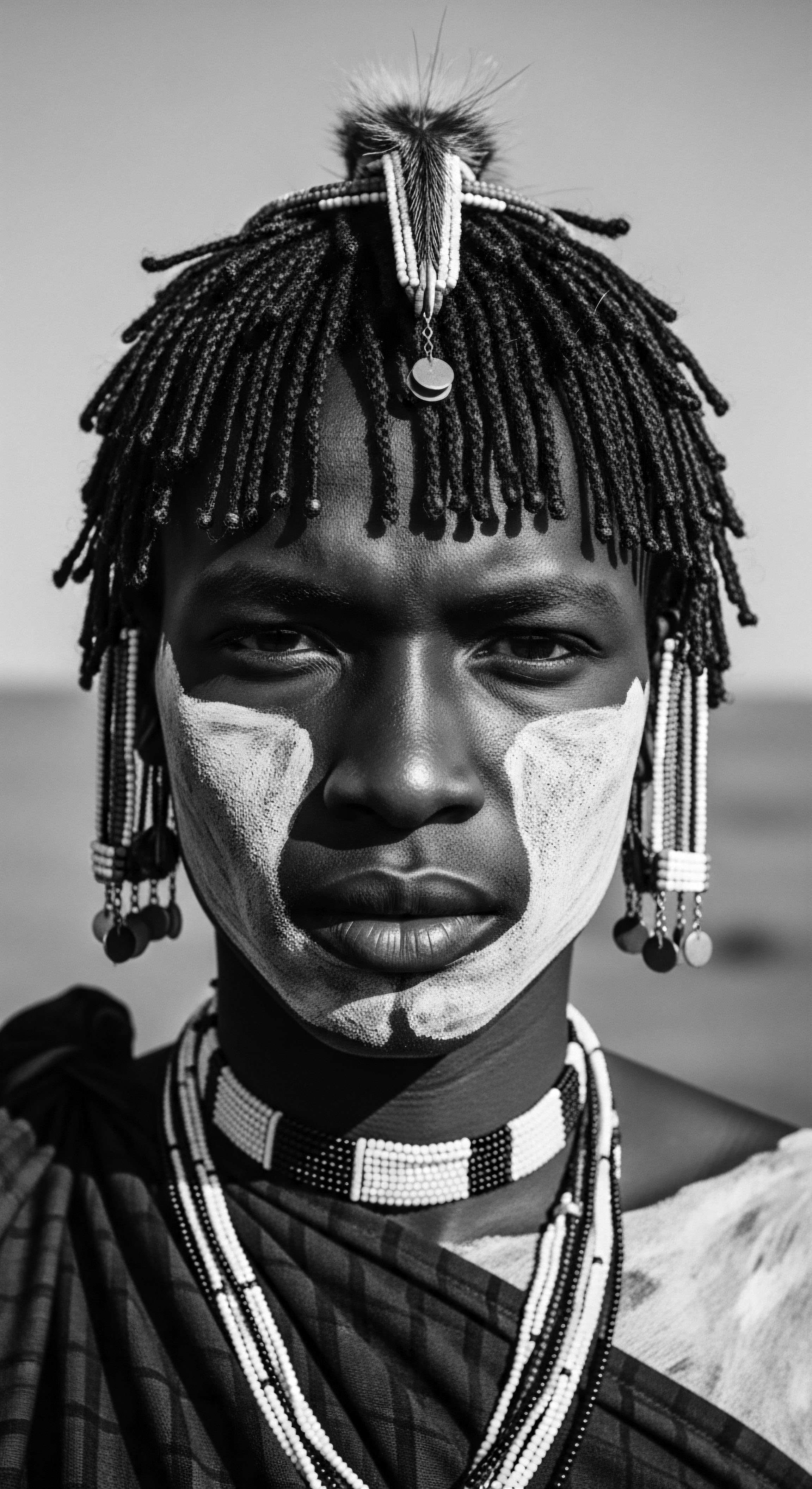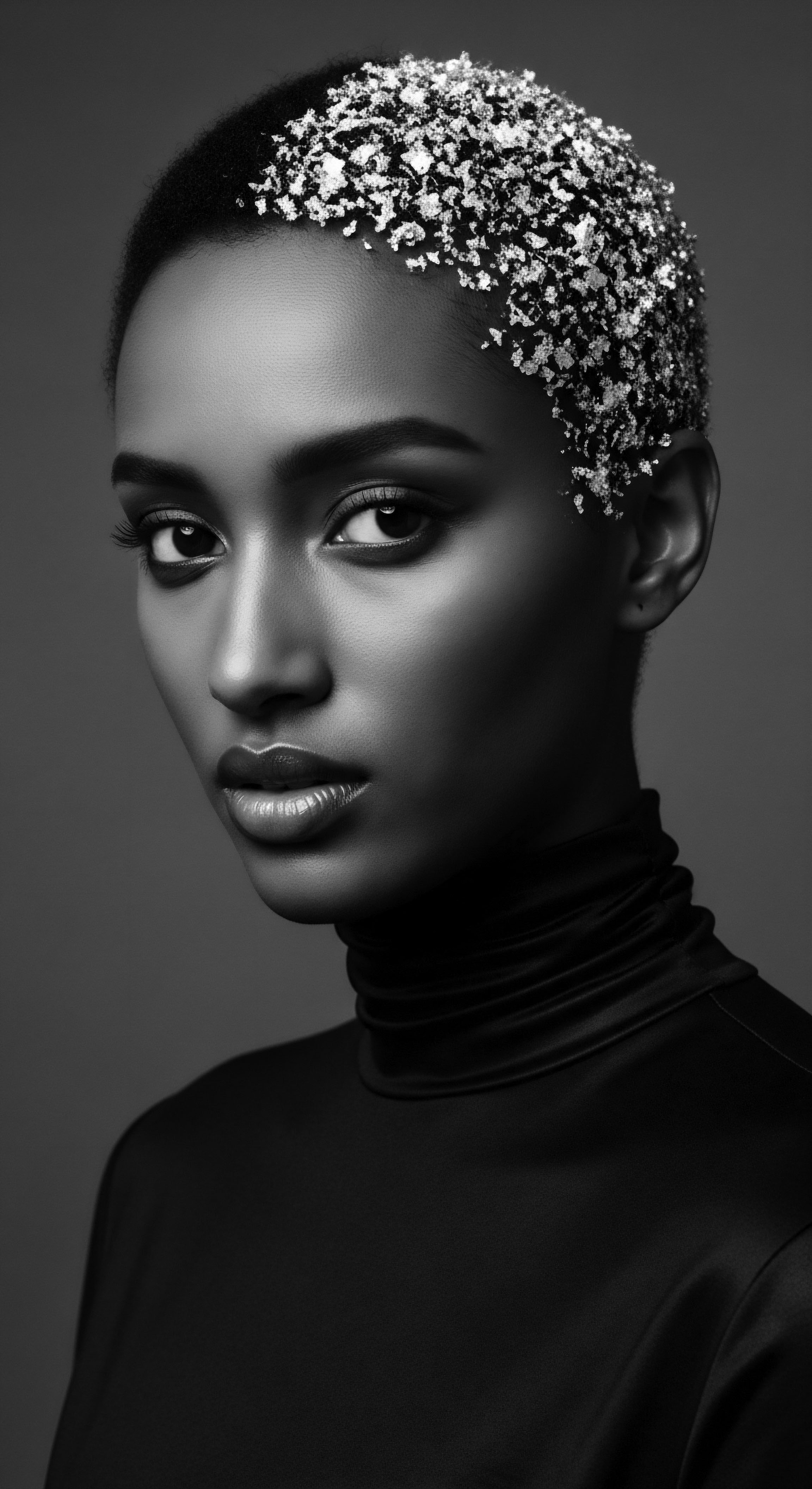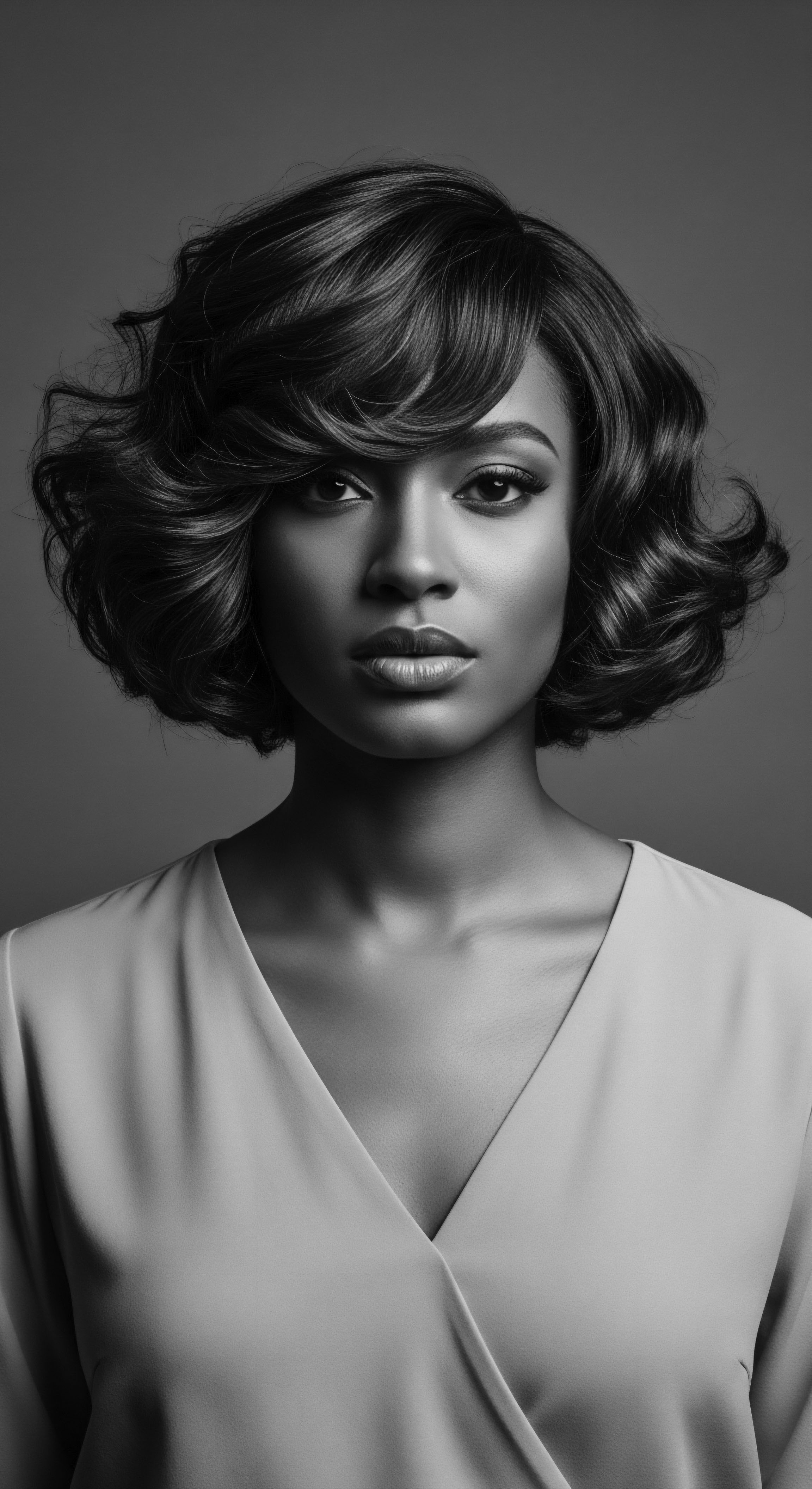
Fundamentals
Hair Development, at its core, refers to the intricate, orchestrated biological process through which hair follicles form, grow, and cycle through various stages of life. This encompasses the very beginnings of a strand within the skin, its emergence, its journey through growth, and its eventual resting and shedding. From a biological perspective, it begins even before birth, with the formation of the hair follicle during embryonic development.
These tiny, specialized organs, nestled within the skin, serve as the biological factories for each individual hair strand. They are truly marvelous structures, guiding the production of keratin, the protein that forms the hair fiber, and dictating its shape, texture, and color.
The initial phases of Hair Development are deeply rooted in our genetic makeup, shaping the very nature of our hair. The unique characteristics of textured hair, for instance, are directly tied to the distinct architecture of its follicles. Unlike straight hair, which typically emerges from round follicles, textured hair springs forth from follicles that are more elliptical or curved, leading to the characteristic coils, kinks, and waves that we celebrate within Black and mixed-race communities. This fundamental distinction is not merely aesthetic; it influences how moisture travels along the strand, how light reflects, and indeed, how care practices have historically evolved to honor its unique needs.
Hair Development is the biological journey of hair, from its genesis within the follicle to its visible emergence, profoundly influenced by ancestral genetic blueprints that shape its texture and resilience.
Ancestral wisdom, passed down through generations, has always recognized the inherent qualities of textured hair, intuitively understanding aspects of its development long before scientific terms existed. These traditions often emphasized practices that worked in harmony with the hair’s natural inclinations, focusing on retention of moisture and gentle handling to honor its delicate yet strong nature. Understanding these basic principles of Hair Development allows for a deeper appreciation of the wisdom embedded in centuries of hair care rituals across the African diaspora.

The Hair Follicle ❉ A Heritage Blueprint
The hair follicle acts as the foundational blueprint for each strand. Its shape and orientation determine the resulting hair texture. In individuals with textured hair, the follicle is typically elliptical or even ribbon-like, causing the hair shaft to twist and curl as it grows.
This distinguishes it from rounder follicles that yield straight hair. This biological truth underpins the visible diversity of human hair, a diversity particularly rich within African populations who exhibit the widest range of hair textures.
The biological reality of the curved follicle also means that the natural oils produced by the scalp, known as sebum, do not easily travel down the length of coiled strands. This contributes to the inherent dryness often experienced by textured hair, a dryness that ancestral care practices inherently addressed through the regular application of nourishing butters, oils, and humectants. Such practices were not simply about aesthetics; they were responses to the very biological definition of Hair Development in these hair types.
- Anagen Phase ❉ This is the growth phase, where hair cells rapidly divide in the follicle’s matrix, extending the hair shaft. For textured hair, this phase can sometimes be shorter compared to other hair types, which impacts overall length potential.
- Catagen Phase ❉ A transitional phase, lasting a few weeks, where hair growth ceases and the follicle shrinks.
- Telogen Phase ❉ The resting phase, during which the hair detaches from the follicle.
- Exogen Phase ❉ The shedding phase, where the old hair falls out, making way for a new anagen hair.
This cyclical pattern of Hair Development, although universal, expresses itself uniquely in different hair types. The length of the anagen phase, for example, directly impacts the potential maximum length a hair strand can achieve.

Intermediate
Moving beyond the elemental definition, Hair Development encompasses the intricate interplay of genetics, cellular processes, and environmental factors that govern a strand’s entire lifecycle. It is a continuous, regenerative process occurring within the skin’s specialized structures, the hair follicles. Each follicle acts as a miniature organ, orchestrating the creation of hair fibers through a highly regulated cycle of growth, regression, and rest. This cyclical nature, while universal to human hair, reveals fascinating differences in its expression across various populations, particularly those with a heritage of textured hair.
Understanding the significance of Hair Development for textured hair communities involves appreciating not just the biological mechanisms but also the historical and cultural narratives intertwined with these natural inclinations. The physical characteristics of Afro-textured hair, such as its elliptical cross-section and spiraled growth pattern, are directly linked to the shape of the hair follicle. These unique attributes influence how products interact with the hair, how moisture is retained, and how styling techniques have been innovated over centuries to protect and celebrate its inherent qualities.
The journey of Hair Development in textured hair is a testament to inherent resilience, a biological narrative intimately woven with ancestral practices of care and cultural identity.

The Genetic Footprint on Hair Development
Genetic factors play a significant role in determining hair texture, dictating whether hair will be straight, wavy, or tightly coiled. Research suggests that various genes influence hair thickness and texture differently across ethnic groups. For instance, polymorphisms in genes like EDAR and FGFR2 are linked to hair thickness in Asian populations, while the TCHH gene shows connections to hair texture in individuals of Northern European ancestry. Within the spectrum of African hair diversity, these genetic influences contribute to the wide array of curl patterns observed.
The curvature of the hair follicle, a key determinant of curl, has a strong genetic basis. This explains why Afro-textured hair is characterized by a highly curved, S-shaped follicle, which leads to tightly coiled strands. This follicular structure also affects how disulfide bonds form within the hair protein, further influencing the curl pattern and contributing to points of potential weakness that require mindful care.

Ancestral Wisdom and the Science of Hair Development
For generations, ancestral practices have provided profound insight into nurturing textured hair, often without formal scientific explanation. These practices frequently aligned with what modern science now elucidates about Hair Development. For instance, traditional African hair care often involved the regular use of natural butters, herbs, and powders to retain moisture, a crucial aspect for hair types prone to dryness due to their follicle shape. The use of Chébé Powder by the Bassara/Baggara Arab tribe in Chad, dating back centuries, exemplifies this.
The powder, when mixed with water and moisturizers like shea butter, was applied to hair and then braided, a method believed to aid length retention by sealing the cuticle and filling hair shaft spaces. This historical practice intuitively addressed the mechanical fragility and moisture needs inherent in the development of coiled hair structures.
| Ancestral Practice (Region/Community) African Hair Threading (Yoruba, Nigeria, 15th century) |
| Underlying Principle in Hair Development Length retention and hair stretching, protecting hair from breakage. |
| Modern Scientific Link Mechanical manipulation to temporarily alter curl pattern, reducing tensile stress on strands, mimicking heat-free stretching for length visibility. |
| Ancestral Practice (Region/Community) Chébé Powder Application (Chad, Bassara/Baggara Arab tribe) |
| Underlying Principle in Hair Development Moisture sealing and cuticle protection for length retention. |
| Modern Scientific Link Protects hair shaft and fills cuticle spaces, enhancing moisture preservation and minimizing mechanical abrasion. |
| Ancestral Practice (Region/Community) Regular Oiling & Buttering (Various African cultures) |
| Underlying Principle in Hair Development Lubrication, moisture retention, and scalp health. |
| Modern Scientific Link Reduces friction between strands, forms occlusive barrier to prevent water loss, nourishes scalp for optimal follicle function. |
| Ancestral Practice (Region/Community) These practices, honed over centuries, reveal an deep, empirical understanding of Hair Development long before contemporary scientific nomenclature. |
This blend of ancestral wisdom and scientific clarity reminds us that the history of hair care is a dynamic testament to human ingenuity and observation, particularly within communities whose hair challenged dominant beauty ideals.

Academic
The precise meaning of Hair Development, from an academic vantage, encompasses the complex, multi-stage morphogenesis of the pilosebaceous unit, its cyclical regeneration throughout life, and the intricate genetic and epigenetic regulatory networks that govern its morphological and physiological characteristics. It is a profound biological orchestration, initiating in utero with the formation of the hair placode and dermal condensate, progressing through distinct phases of active growth (anagen), transitional regression (catagen), and quiescent rest (telogen), culminating in the shedding of the old hair (exogen) as a new one begins its journey. This precise delineation extends beyond mere physical growth to include the cellular differentiation, protein synthesis (notably keratinization), and melanin production that define the hair fiber’s color and structural integrity.
The academic understanding of Hair Development is further enriched by recognizing the profound impact of genetic variations on hair morphology, particularly evident in the highly diverse hair textures of individuals of African descent. The elliptical or flat cross-sectional shape of the hair follicle, a feature distinct in coiled hair, directly correlates with the degree of curvature and torsion along the hair shaft. This structural particularity, driven by genetic predispositions, influences mechanical properties, porosity, and the propensity for knotting and breakage.
The academic investigation of Hair Development reveals a symphony of biological precision, where genetic legacies sculpt the very architecture of hair, deeply informing its cultural and ancestral resonance.

Genomic Underpinnings and Hair Development
Recent advancements in genomic research have begun to clarify the specific genetic determinants of hair morphology. While multiple genes contribute to hair texture and thickness across diverse populations, a noteworthy example is the ectodysplasin A receptor (EDAR) gene. Polymorphisms in EDAR, specifically the 1540T/C allele, have been significantly associated with increased hair thickness in Asian populations.
Though research continues to precisely map the full genetic landscape of textured hair, it is understood that the unique follicular architecture of Afro-textured hair, including its pronounced curvature at the bulb and asymmetrical S-shape, is genetically controlled. This inherent biological design accounts for its distinctive coiling, which in turn presents both a magnificent display of natural variation and unique considerations for its care.
The interplay of genes, cellular signaling pathways, and environmental factors throughout the Hair Development cycle underscores its complexity. For example, the duration of the anagen phase, genetically influenced, dictates the maximum length hair can achieve. For some textured hair types, a shorter anagen phase may mean a reduced ultimate length, yet this does not diminish its vitality or cultural significance.

Hair Development and the Lived Experience ❉ A Socio-Historical Lens
The academic examination of Hair Development must transcend pure biology, extending into the socio-historical and cultural implications, particularly for Black and mixed-race communities. Historically, hair has served as a powerful marker of identity, status, and communication across African societies. In pre-colonial Africa, hairstyles communicated geographic origin, marital status, age, wealth, and spiritual beliefs. This deep cultural integration of hair into identity meant that the forced shaving of heads during the transatlantic slave trade was a profoundly dehumanizing act, a deliberate attempt to strip enslaved Africans of their culture and identity.
In the aftermath of emancipation, the concept of “good hair” versus “bad hair” emerged, with straight, Eurocentric hair textures being deemed superior, coercing many Black individuals to adopt chemical straightening methods for social acceptance and economic opportunity. This historical oppression of natural hair highlights how the biological reality of Hair Development in textured hair was weaponized within a system of racial hierarchy.
A powerful case study illuminating the Hair Development’s profound connection to Black heritage and experiences is the widespread adoption of the Afro Hairstyle during the Black Power Movement of the 1960s and 1970s. This period marked a significant shift in the perception and expression of Hair Development within the African diaspora. As noted by research, “the Afro became a powerful symbol of black pride, reclaiming cultural heritage and challenging societal norms.” It was a deliberate rejection of imposed Eurocentric beauty standards and an unapologetic affirmation of indigenous African identity. This was not merely a stylistic choice; it was a sociopolitical statement rooted in the physical manifestation of naturally developing coiled hair, asserting autonomy and celebrating the inherent beauty of Afro-textured Hair Development.
Trejha Whitfield, a Black feminist scholar, reflects that “whether I choose to wear my hair natural in an afro, or style it in locs, braids, or wear a weave, I’m sending a message to the world about my identity. That choice can be conscious or unconscious and can also be a political statement or an act of empowerment.” The re-emergence of the Afro demonstrated how the natural outcome of Hair Development could be transformed into a potent symbol of resistance and collective identity, validating ancestral aesthetics and challenging systemic discrimination.
This reclamation of natural hair, a direct outcome of Hair Development, continues through the Natural Hair Movement of the 21st century, which pushes for greater acceptance and understanding of coiled hair textures in various settings. The ongoing legislative efforts, such as the CROWN Act in the United States, aim to prohibit race-based hair discrimination, recognizing the historical and ongoing impact of policing natural hair textures in professional and educational environments.
- Dehumanization During Enslavement ❉ The forcible shaving of heads severed a critical link to ancestral identity and spiritual heritage.
- “Good Hair” Vs. “Bad Hair” Paradigm ❉ Post-emancipation, societal pressures led to the widespread chemical straightening of natural hair, perpetuating a discriminatory beauty standard.
- The Afro as a Political Statement ❉ The Black Power Movement embraced the Afro, turning the natural expression of Hair Development into a potent symbol of pride and resistance against oppressive norms.
The academic lens reveals that Hair Development is not merely a biological phenomenon; it is a profound site of cultural memory, social struggle, and ongoing liberation, especially within the context of Black and mixed-race hair experiences.

Reflection on the Heritage of Hair Development
As we close this contemplation on Hair Development, the whispers of ancient wisdom and the echoes of resilient strands gently settle. It is a profound meditation on the journey of each hair, from its hidden origins within the follicle to its vibrant declaration in the world, forever intertwined with the heritage it carries. This biological miracle is, for textured hair, a living archive of endurance, a testament to the ingenuity and spirit of communities who have consistently found ways to honor and adorn their crowns against tides of erasure and prejudice.
The meticulous patterns of African braids, the nourishing butters coaxed from the earth, the ceremonial significance of each coil and twist – these were not simply beauty routines. They were profound acts of connection, spiritual practices, and ingenious responses to the unique needs of hair that defied easy categorization by dominant standards. The path of Hair Development for Black and mixed-race individuals is a story of resistance woven into every strand, a quiet affirmation of self in the face of imposed ideals.
It reminds us that care is not just about physical health, but about spiritual grounding, cultural preservation, and the soulful act of acknowledging where we come from. The unbound helix of our hair, therefore, voices identity and shapes futures, carrying the deep past within its very structure, inviting us to listen and learn from its enduring wisdom.

References
- Byrd, A. D. & Tharps, L. (2014). Hair Story ❉ Untangling the Roots of Black Hair in America. St. Martin’s Press.
- Jacobs-Huey, L. (2006). From the Kitchen to the Salon ❉ Language and Cultural Co-Construction in the African American Hair-Care Industry. Indiana University Press.
- Banks, I. (2000). Hair Matters ❉ Beauty, Power, and Black Women’s Consciousness. New York University Press.
- Mbilishaka, A. Mofolorunsho, C. & Green, B. L. (2020). Hair as a Metaphor for Identity and Resistance in the African Diaspora. Journal of Black Psychology.
- Patton, T. D. (2006). Our Hair, Our Selves ❉ Identity, Culture, and the African American Experience. Journal of Black Studies.
- Rooks, N. M. (1996). Hair Raising ❉ Beauty, Culture, and African American Women. Rutgers University Press.
- Roberts, S. (2003). African American Hair as Culture and Commodity. In K. Peiss & S. Roberts (Eds.), Beauty and the Culture of American Appearance .
- Dutton, R. (2007). The Cultural History of Hair. Greenwood Press.
- Sclafani, A. & Cohen, A. J. (2020). The Biology of Hair Follicles. StatPearls.
- Chapman, B. (2007). The Biology of Hair. Dermatology in Clinical Practice.
